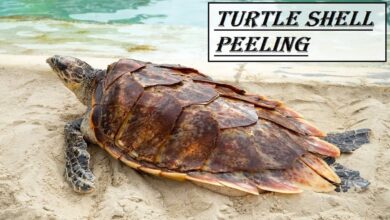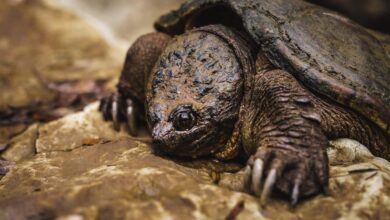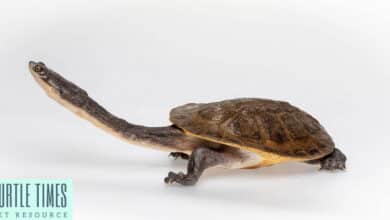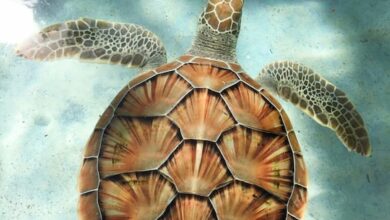Mata Mata Turtle
Mata Mata Turtle (Chelus fimbriata)
The mata mata turtle has a special look with its big, triangle-shaped head. They come from South America and live differently than most turtles. Because they like to stay in one place and need a certain type of home, they’re tough for new turtle owners to look after.
Mata Mata Turtle Origin
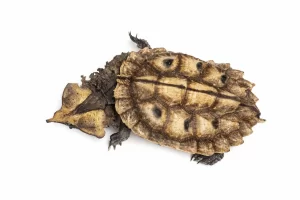
The mata mata turtle, scientifically known as Chelus fimbriata, has its roots in the freshwater habitats of South America. They prefer the slower currents of ponds, rivers, streams, and marshes. Countries like Colombia, Peru, Brazil, Venezuela, Ecuador, and Bolivia are proud to claim their presence. Interestingly, their range also extends to the Island of Trinidad.
In their natural environment, mata matas are exclusively aquatic, making the water their sole domain. However, don’t mistake them for prolific swimmers. Contrary to what one might expect, these turtles are not adept swimmers. Instead, they have a preference for waters shallow enough that allows them to simply stand. By doing so, they can effortlessly raise their snouts to the surface, accessing the fresh air above. This behavior is a testament to the turtle’s unique lifestyle and its adaptations to its specific environment.
Mata Mata Turtle Choosing and Buying
Investing in a mata mata turtle can be an exhilarating experience given their distinctive appearance and intriguing behavior. However, buying one requires a thorough understanding and consideration of various factors to ensure both the welfare of the turtle and your satisfaction.
Mata Mata Turtle Pricing
Typically, the cost of acquiring a mata mata turtle ranges from $250 to $550. This price can fluctuate based on factors like the turtle’s age, size, health, and even its lineage. While this might seem steep for a reptile, remember that the rarity and specialized care requirements of mata matas often dictate this price range.
Mata Mata Turtle Sellers
Always ensure you purchase your mata mata turtle from a reputable breeder or a trusted online reptile store. Established breeders often have years of experience in nurturing these animals, and they can provide valuable insights into the turtle’s history, health, and care needs. Moreover, trusted online stores usually have detailed reviews and ratings from previous buyers which can be instrumental in making an informed decision.
Mata Mata Turtle Laws
Despite their captivating appearance, mata mata turtles are not commonly found in typical pet stores. While it’s legal to buy imported mata matas, consider the environmental implications of such a decision. Removing these turtles from their natural habitats can strain local ecosystems and potentially disrupt the balance of species. As such, it is more ecologically responsible and often beneficial for the turtle’s health to choose a captive-bred mata mata. These turtles are bred in controlled environments, ensuring they are free from many of the potential hazards and diseases found in the wild.
Mata Mata Turtle Physical Check
Before finalizing your purchase, if possible, view the mata mata turtle in person. This hands-on inspection allows you to:
- Shell Inspection: Examine the turtle’s shell. A healthy mata mata will have a hard, smooth shell, devoid of cracks, soft spots, or other defects. This shell is the turtle’s primary defense mechanism and a significant indicator of its overall health.
- Head and Eyes Inspection: The head is another vital area to inspect. Ensure that the turtle’s eyes are clear, bright, and free of any discharge or mucus. Cloudy eyes or a mucus-covered snout can be indicators of potential health issues or infections.
How To Care For A Mata Mata Turtle
Handling
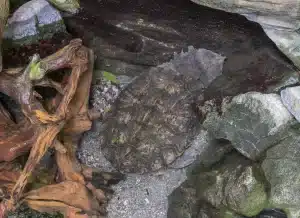
The Mata Mata turtle can be a big commitment as a pet, so make sure the space is prepared sooner rather than later. Eventually, this species is likely to require more than just a tank, and an indoor pond is more appropriate long term. Always judge the size of the individual and ensure they can move around freely when designing the pond area. This species is fully aquatic, so a land area isn’t necessary as they don’t leave the water to bask.
Despite being strictly aquatic, Mata Matas aren’t great swimmers and require a substrate to ‘walk on’ like a gravel mix to give them traction. You can also use a variety of rocks, wood pieces, and foliage to provide good leverage for movement as well as create a more natural setting. The Mata Mata will hide amongst decor on the floor but covered areas from surface foliage will also make your turtle feel more secure.
Water conditions for the Mata Mata can be difficult to get right. They require a low pH of 5 – 5.5 (7 being neutral), and tannins from leaf litter, peat, and wood. This can make the color of the water slightly brown but it is best when creating an Amazonian Mata Mata environment. RO water can be used as a source of low-pH freshwater.
Mata Mata Turtle Common Health Issues
Diet plays an important role in the overall health of mata mata turtles. Their nutritional intake is directly proportional to the quality of food they consume. A diet lacking essential nutrients can render these turtles lethargic and hinder their growth. To circumvent such issues, offer them a varied selection of high-quality live foods, ensuring they receive a well-rounded nutritional profile.
Secondly, Mata Matas, being tropical species, are sensitive to their atmospheric environment. Insufficient warmth and humidity in their habitat can predispose them to respiratory infections. Common manifestations include swollen eyelids, labored breathing through the mouth, and nasal discharge. It’s imperative to maintain optimal temperature and humidity levels, regularly monitored using reliable thermometers and hygrometers.
Thirdly, given their preference for live foods, Mata Matas are susceptible to parasitic infections. The ingestion of infected fish can introduce parasites like worms and amoebas into their system. Such infections can manifest as vomiting, diarrhea, or noticeable weight loss. Should you suspect a parasitic infection, it’s advisable to consult with a veterinarian promptly for appropriate intervention.
Finally, appearances can be deceiving. Although the mata mata’s shell appears robust, it’s vulnerable to injuries. Traumas from collisions, abrasions, or falls can compromise their shell’s integrity. Ensuring a safe habitat, devoid of potential hazards like steep terrains or abrasive materials, is crucial to avoid such incidents. Regularly inspect their living space and modify it to eliminate any risks.
Mata Mata Turtle Appearance and Behavior
Mata matas have a captivating and unconventional appearance that polarizes opinions – some are drawn to their distinctive looks while others find them off-putting. Their carapace, or upper shell, presents a rough, rugged terrain marked by knobs and bumps, a far cry from the smooth shells commonly associated with turtles. Complementing this is their large triangular head that tapers into a long, snorkel-like snout.
The dominant hues of the mata mata are earthy. The carapace sports a deep, dark brown while the plastron, or the underside, is often a shade of brown or yellow. A unique feature is the growth of algae on the turtle’s shell. This isn’t a result of negligence but rather a consequence of the turtle’s sedentary lifestyle. This algal cloak further enhances its camouflage, allowing the turtle to meld seamlessly with its surroundings.
The skin on their legs, head, and tail embraces a grayish-brown palette. Their feet, designed for gripping rather than swift swimming, are webbed. Each front foot flaunts five claws, while the back ones have four.
While mata matas are not gifted with great vision, they are far from defenseless. Nature has equipped them with unique sensory adaptations to navigate their world. Fleshy protrusions and flaps drape the sides of their head and neck. These are not merely ornamental features but are embedded with nerves that can detect the faintest vibrations, alerting them to approaching prey or potential threats.
Furthermore, gender distinctions are evident in their physical attributes. Males possess concave plastrons, allowing them to mount females during mating. Additionally, they sport thicker tails than their female counterparts.
Mata Mata Turtle Size and Lifespan
An adult mata mata turtle can achieve impressive dimensions, stretching up to 24 inches from head to tail. However, in captivity, they typically reach lengths between 16 and 20 inches. Intriguingly, the genders are on equal footing here, with no noticeable size disparities between male and female specimens.
In terms of longevity, these turtles are resilient creatures. Under human care, they can live for up to 15 years. However, when left to the devices of the wild, some have been documented to surpass 30 years, attesting to their hardy nature.
Mata Mata Turtle Temperament and Behavior
Mata matas exemplify the art of stillness. They are quintessential loners, cherishing their solitude and rarely venturing out of their comfort zones. Swimming isn’t their forte; they are more akin to statues standing in shallow waters, patiently waiting for prey to stray too close.
Despite their passive demeanor, it’s wise to house mata matas individually. They might not be territorial, but their preference for solitude remains undeniable. Those seeking a hands-on pet might want to reconsider their choice. Mata matas aren’t enthusiastic about human interaction. They are averse to being lifted from their watery haven, and when discomfort, they aren’t shy about flashing their snapping side.
Housing Mata matas
Originating from tropical freshwater habitats like slow-moving streams, swamps, and rivers, mata matas have evolved to thrive in specific environmental conditions. In captivity, it’s crucial to emulate their natural surroundings as closely as possible. This ensures their well-being and reduces the stress of adaptation. To achieve this, maintain a heated aquatic setup, allowing the mata matas ample space to move, explore, and express their natural behaviors. Choose a sizable vivarium for housing mata matas. A well-sized tank not only aids in creating an optimum environment but also offers space for the turtle to grow.
Enclosure Size
For the youngest of the species, the hatchlings or juveniles, a 60-gallon tank with a water depth of about 4 inches suffices. However, mata matas display a remarkable growth rate. Thus, as they transition into adulthood, their space needs to burgeon. Adult mata matas require an expansive tank, typically ranging from 100 to 150 gallons. As a rule of thumb, you should provide 10 liters of water for every inch of the turtle’s length. The ideal dimensions for a body of water are 10 inches deep, 48 inches in length, and 48 inches in breadth.
Lighting
Proper lighting is important for the well-being of mata matas. Inadequate light exposure can induce undue stress and pave the way for various health concerns.
UVB Bulb: A UVB bulb, crucial for synthesizing vitamin D3 and calcium absorption, is non-negotiable for a mata mata’s enclosure. Ensure that you position this bulb centrally on the vivarium roof to disseminate an even light spread. Given their aquatic nature, it’s recommended to opt for a high-powered, compact fluorescent UV bulb, ensuring that the UV rays permeate the water where mata matas predominantly dwell. Generally, these bulbs necessitate replacement every six months or as recommended by the manufacturer.
Lighting Duration: Mata matas thrive when subjected to 10-12 hours of UVB light daily. To mimic a natural day-night rhythm, set up a timer that operates the light for 12 hours during daytime hours.
Temperature and Humidity
Despite their predilection for remaining submerged, mata matas still necessitate a basking zone. A heat lamp, ranging between 75 to 150 watts and calibrated to emit temperatures between 93-97°F, should be anchored approximately 12 inches above a dry basking spot.
The aquatic section of the vivarium, or the parts that aren’t directly underneath the basking light, should consistently hover between 75 and 85°F. If the basking light doesn’t suffice in warming the entirety of the setup, consider introducing a ceramic heat emitter or an aquarium heater. Routinely monitor temperatures using a reliable thermometer to ensure consistent warmth.
One of the perks of housing mata matas is that they don’t necessitate specialized humidity gear like misters. The evaporation from the heated water typically provides adequate humidity for the vivarium.
Substrate and Decoration
In nature, mata matas frequent environments that have soft, sandy substrates. Emulate this by opting for a substrate made of sand or smooth pebbles that feels soft underfoot and allows the turtle to traverse with ease. However, steer clear of substrates with jagged or abrasive constituents. These have the potential to harm the delicate underbelly of the turtle. Instead, a substrate of smooth-pebble gravel fits the bill.
Despite mata matas being predominantly aquatic, incorporating a dry zone or basking area remains vital. Employ smooth rocks or substantial logs to create this basking niche or craft an island within the aquatic setup.
Mata matas, like many other aquatic animals, find solace in hiding spots. Incorporating aquatic or faux plants can offer such sanctuaries and play a role in reducing stress levels. Plants like Anubis and Java ferns are recommended, thanks to their deep-rooted nature.
Food and Water
Mata matas have an inherent carnivorous streak, gravitating towards a diet dominated by fish, aquatic worms, and insects in their natural habitats. It’s pivotal to echo this dietary pattern in captivity. Generic commercial turtle feeds often fall short of meeting the nutritional needs of mata matas.
Offer mata matas a varied diet comprised of live prey items like earthworms, guppies, goldfish, minnows, mollies, and mussels. Renowned for their vacuum-like feeding style, mata matas gulp down their prey. Their relatively weaker jaws mean they prefer food that doesn’t necessitate chewing.
To facilitate effortless feeding, stock the enclosure with an ample quantity of food items, roughly around 40, distributed across the tank. With mata matas being sluggish feeders, this ensures they don’t face challenges while feeding. When the count drops below 30, it’s time for a refill.
Juvenile mata matas are like the dietary preferences of adults but necessitate smaller portions. Live food items like earthworms or feeder fish, such as guppies and mosquitofish, are ideal for their diminutive size.
Mata Mata Turtle Breeding
Nature sees mata matas engaging in breeding activities, typically between October and November. They prefer open, sandy terrains for egg-laying. Post-laying, eggs undergo an incubation phase, lasting roughly 200 days, culminating in hatching.
Breeding mata matas in captivity isn’t widespread among hobbyists. The sheer size of the tank needed to comfortably accommodate two turtles is often a deterrent. Given the limited knowledge of breeding mata matas, it’s not advised for non-professional breeders to embark on such endeavors.
Cleaning
A pristine habitat is the cornerstone of a healthy mata mata turtle. Given the substantial aquatic component of their habitat, robust filtration becomes paramount. Invest in a powerful filter apt for the tank size. Periodically inspect the filter, clearing it of any shed skin or waste, preventing clogs.
Despite filtration efforts, manual water changes remain indispensable. Adopt a weekly routine of partial water changes, replacing roughly a third of the water volume. During this process, the mata mata can continue to reside in the tank.
It is recommended to do cleaning every two weeks. Start by looking for waste accumulation or shed skin. When required, give plant leaves a gentle wipe and clean the basking area. The latter task is typically less demanding given the mata mata’s aquatic preference.
Conclusion
Mata mata turtles are unique creatures with specific care requirements. From their striking appearance and behavior to their housing needs, it’s needed to mimic their natural environment and diet for their well-being in captivity. Moreover, breeding these turtles in captivity remains a challenge due to space and knowledge constraints. So, while mata matas might not be for everyone, with the right care and attention, they can thrive and make fascinating additions to any home or aquarium.

